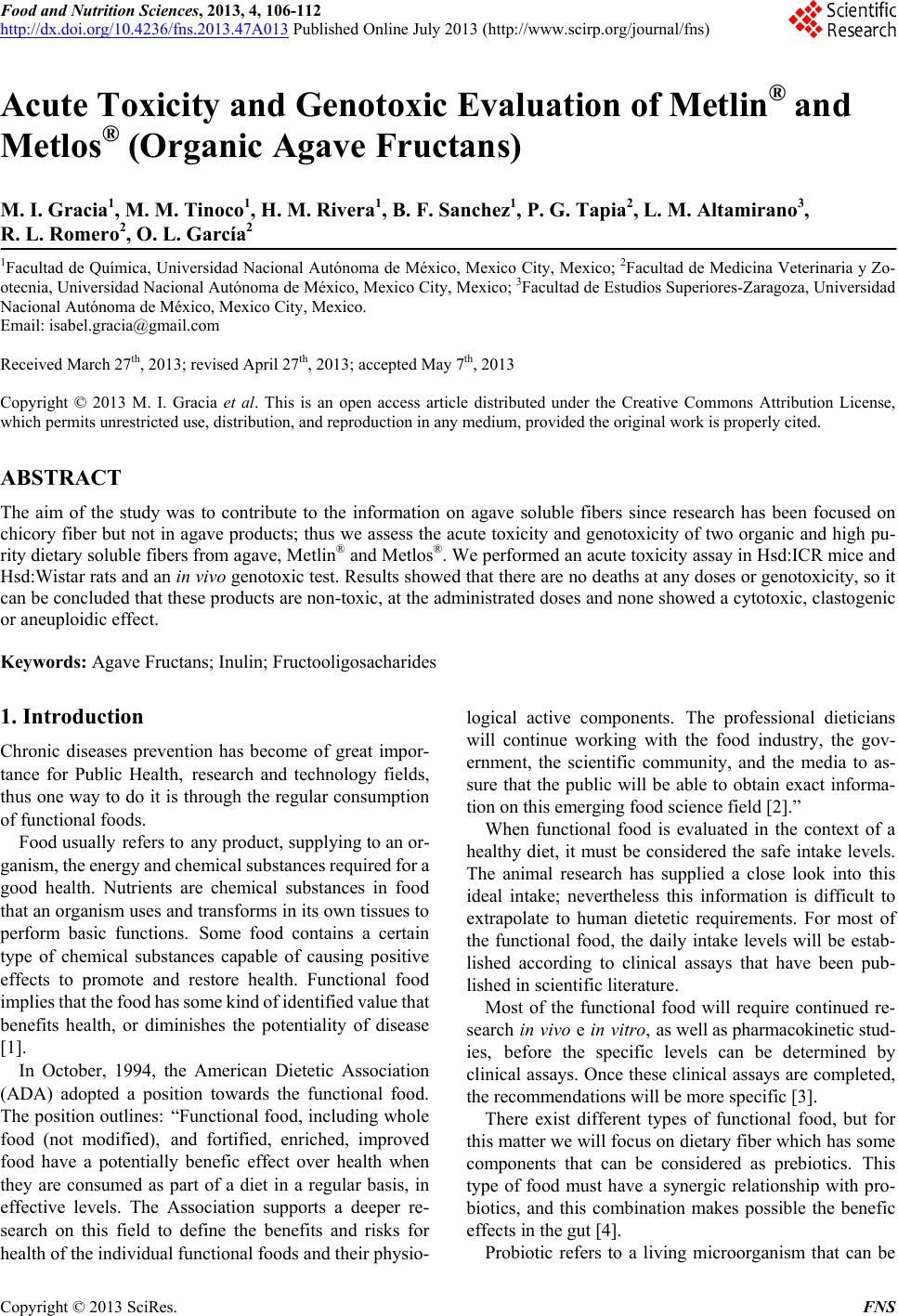 Food and Nutrition Sciences, 2013, 4, 106-112 http://dx.doi.org/10.4236/fns.2013.47A013 Published Online July 2013 (http://www.scirp.org/journal/fns) Acute Toxicity and Genotoxic Evaluation of Metlin® and Metlos® (Organic Agave Fructans) M. I. Gracia1, M. M. Tinoco1, H. M. Rivera1, B. F. Sanchez1, P. G. Tapia2, L. M. Altamirano3, R. L. Romero2, O. L. García2 1Facultad de Química, Universidad Nacional Autónoma de México, Mexico City, Mexico; 2Facultad de Medicina Veterinaria y Zo- otecnia, Universidad Nacional Autónoma de México, Mexico City, Mexico; 3Facultad de Estudios Superiores-Zaragoza, Universidad Nacional Autónoma de México, Mexico City, Mexico. Email: isabel.gracia@gmail.com Received March 27th, 2013; revised April 27th, 2013; accepted May 7th, 2013 Copyright © 2013 M. I. Gracia et al. This is an open access article distributed under the Creative Commons Attribution License, which permits unrestricted use, distribution, and reproduction in any medium, provided the original work is properly cited. ABSTRACT The aim of the study was to contribute to the information on agave soluble fibers since research has been focused on chicory fiber but not in agave products; thus we assess the acute toxicity and genotoxicity of two organic and high pu- rity dietary soluble fibers from agave, Metlin® and Metlos®. We performed an acute toxicity assay in Hsd:ICR mice and Hsd:Wistar rats and an in vivo genotoxic test. Results showed that there are no deaths at any doses or genotoxicity, so it can be concluded that these products are non-toxic, at the administrated doses and none showed a cytotoxic, clastogenic or aneuploidic effect. Keywords: Agave Fructans; Inulin; Fructooligosacharides 1. Introduction Chronic diseases prevention has become of great impor- tance for Public Health, research and technology fields, thus one way to do it is through the regular consumption of functional foods. Food usually refers to any product, supplying to an or- ganism, the energy and chemical substances required for a good health. Nutrients are chemical substances in food that an organism uses and transforms in its own tissues to perform basic functions. Some food contains a certain type of chemical substances capable of causing positive effects to promote and restore health. Functional food implies that the food has some kind of identified value that benefits health, or diminishes the potentiality of disease [1]. In October, 1994, the American Dietetic Association (ADA) adopted a position towards the functional food. The position outlines: “Functional food, including whole food (not modified), and fortified, enriched, improved food have a potentially benefic effect over health when they are consumed as part of a diet in a regular basis, in effective levels. The Association supports a deeper re- search on this field to define the benefits and risks for health of the individual functional foods and their physio- logical active components. The professional dieticians will continue working with the food industry, the gov- ernment, the scientific community, and the media to as- sure that the public will be able to obtain exact informa- tion on this emerging food science field [2].” When functional food is evaluated in the context of a healthy diet, it must be considered the safe intake levels. The animal research has supplied a close look into this ideal intake; nevertheless this information is difficult to extrapolate to human dietetic requirements. For most of the functional food, the daily intake levels will be estab- lished according to clinical assays that have been pub- lished in scientific literature. Most of the functional food will require continued re- search in vivo e in vitro, as well as pharmacokinetic stud- ies, before the specific levels can be determined by clinical assays. Once these clinical assays are completed, the recommendations will be more specific [3]. There exist different types of functional food, but for this matter we will focus on dietary fiber which has some components that can be considered as prebiotics. This type of food must have a synergic relationship with pro- biotics, and this combination makes possible the benefic effects in the gut [4]. Probiotic refers to a living microorganism that can be Copyright © 2013 SciRes. FNS 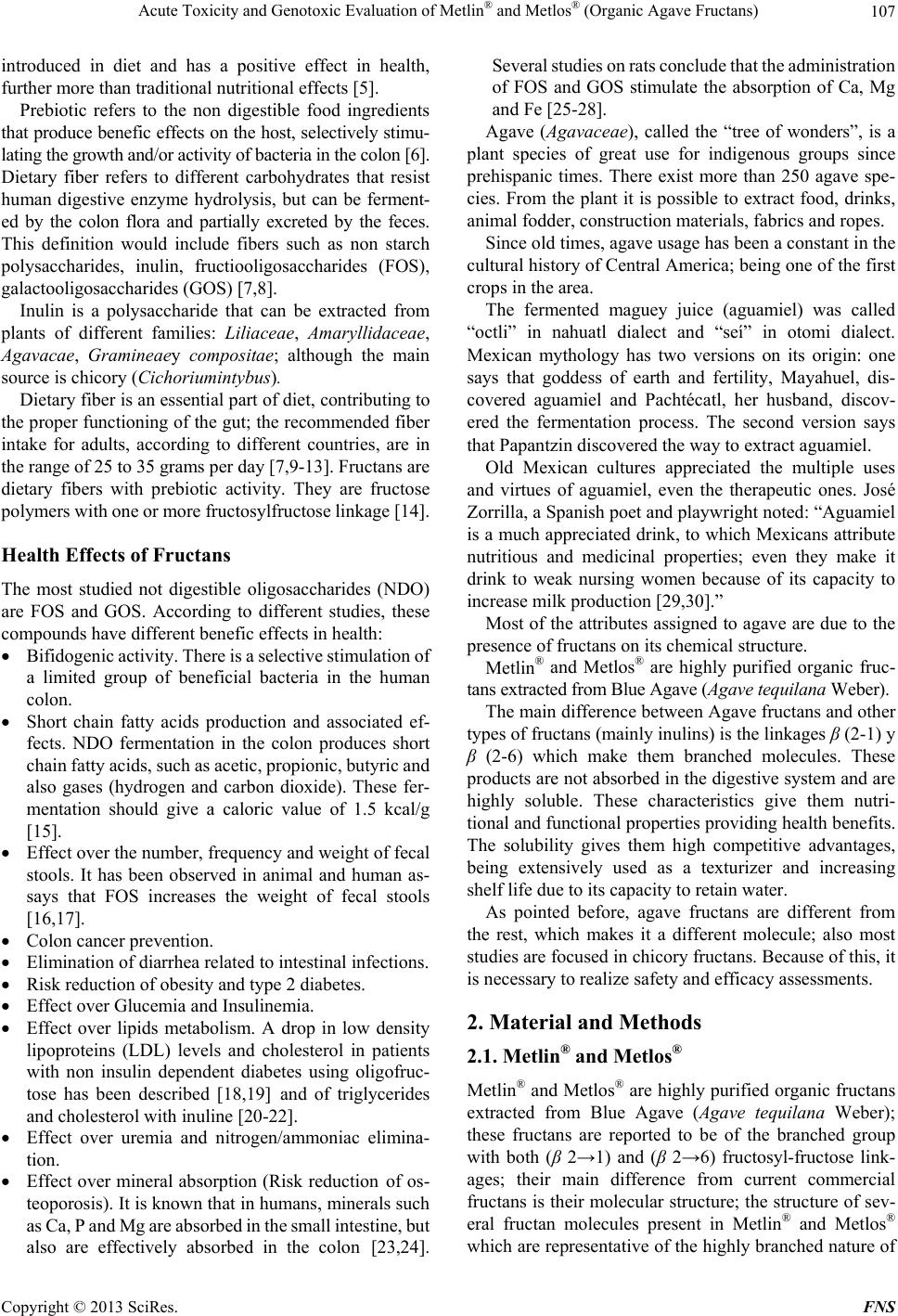 Acute Toxicity and Genotoxic Evaluation of Metlin® and Metlos® (Organic Agave Fructans) 107 introduced in diet and has a positive effect in health, further more than traditional nutritional effects [5]. Prebiotic refers to the non digestible food ingredients that produce benefic effects on the host, selectively stimu- lating the growth and/or activity of bacteria in the colon [6]. Dietary fiber refers to different carbohydrates that resist human digestive enzyme hydrolysis, but can be ferment- ed by the colon flora and partially excreted by the feces. This definition would include fibers such as non starch polysaccharides, inulin, fructiooligosaccharides (FOS), galactooligosaccharides (GOS) [7,8]. Inulin is a polysaccharide that can be extracted from plants of different families: Liliaceae, Amaryllidaceae, Agavacae, Gramineaey compositae; although the main source is chicory (Cichoriumintybus). Dietary fiber is an essential part of diet, contributing to the proper functioning of the gut; the recommended fiber intake for adults, according to different countries, are in the range of 25 to 35 grams per day [7,9-13]. Fructans are dietary fibers with prebiotic activity. They are fructose polymers with one or more fructosylfructose linkage [14]. Health Effects of Fructans The most studied not digestible oligosaccharides (NDO) are FOS and GOS. According to different studies, these compounds have different benefic effects in health: Bifidogenic activity. There is a selective stimulation of a limited group of beneficial bacteria in the human colon. Short chain fatty acids production and associated ef- fects. NDO fermentation in the colon produces short chain fatty acids, such as acetic, propionic, butyric and also gases (hydrogen and carbon dioxide). These fer- mentation should give a caloric value of 1.5 kcal/g [15]. Effect over the number, frequency and weight of fecal stools. It has been observed in animal and human as- says that FOS increases the weight of fecal stools [16,17]. Colon cancer prevention. Elimination of diarrhea related to intestinal infections. Risk reduction of obesity and type 2 diabetes. Effect over Glucemia and Insulinemia. Effect over lipids metabolism. A drop in low density lipoproteins (LDL) levels and cholesterol in patients with non insulin dependent diabetes using oligofruc- tose has been described [18,19] and of triglycerides and cholesterol with inuline [20-22]. Effect over uremia and nitrogen/ammoniac elimina- tion. Effect over mineral absorption (Risk reduction of os- teoporosis). It is known that in humans, minerals such as Ca, P and Mg are absorbed in the small intestine, but also are effectively absorbed in the colon [23,24]. Several studies on rats conclude that the administration of FOS and GOS stimulate the absorption of Ca, Mg and Fe [25-28]. Agave (Agavaceae), called the “tree of wonders”, is a plant species of great use for indigenous groups since prehispanic times. There exist more than 250 agave spe- cies. From the plant it is possible to extract food, drinks, animal fodder, construction materials, fabrics and ropes. Since old times, agave usage has been a constant in the cultural history of Central America; being one of the first crops in the area. The fermented maguey juice (aguamiel) was called “octli” in nahuatl dialect and “seí” in otomi dialect. Mexican mythology has two versions on its origin: one says that goddess of earth and fertility, Mayahuel, dis- covered aguamiel and Pachtécatl, her husband, discov- ered the fermentation process. The second version says that Papantzin discovered the way to extract aguamiel. Old Mexican cultures appreciated the multiple uses and virtues of aguamiel, even the therapeutic ones. José Zorrilla, a Spanish poet and playwright noted: “Aguamiel is a much appreciated drink, to which Mexicans attribute nutritious and medicinal properties; even they make it drink to weak nursing women because of its capacity to increase milk production [29,30].” Most of the attributes assigned to agave are due to the presence of fructans on its chemical structure. Metlin® and Metlos® are highly purified organic fruc- tans extracted from Blue Agave (Agave tequilana Weber). The main difference between Agave fructans and other types of fructans (mainly inulins) is the linkages β (2-1) y β (2-6) which make them branched molecules. These products are not absorbed in the digestive system and are highly soluble. These characteristics give them nutri- tional and functional properties providing health benefits. The solubility gives them high competitive advantages, being extensively used as a texturizer and increasing shelf life due to its capacity to retain water. As pointed before, agave fructans are different from the rest, which makes it a different molecule; also most studies are focused in chicory fructans. Because of this, it is necessary to realize safety and efficacy assessments. 2. Material and Methods 2.1. Metlin® an d Metlo s® Metlin® and Metlos® are highly purified organic fructans extracted from Blue Agave (Agave tequilana Weber); these fructans are reported to be of the branched group with both (β 2→1) and (β 2→6) fructosyl-fructose link- ages; their main difference from current commercial fructans is their molecular structure; the structure of sev- eral fructan molecules present in Metlin® and Metlos® which are representative of the highly branched nature of Copyright © 2013 SciRes. FNS 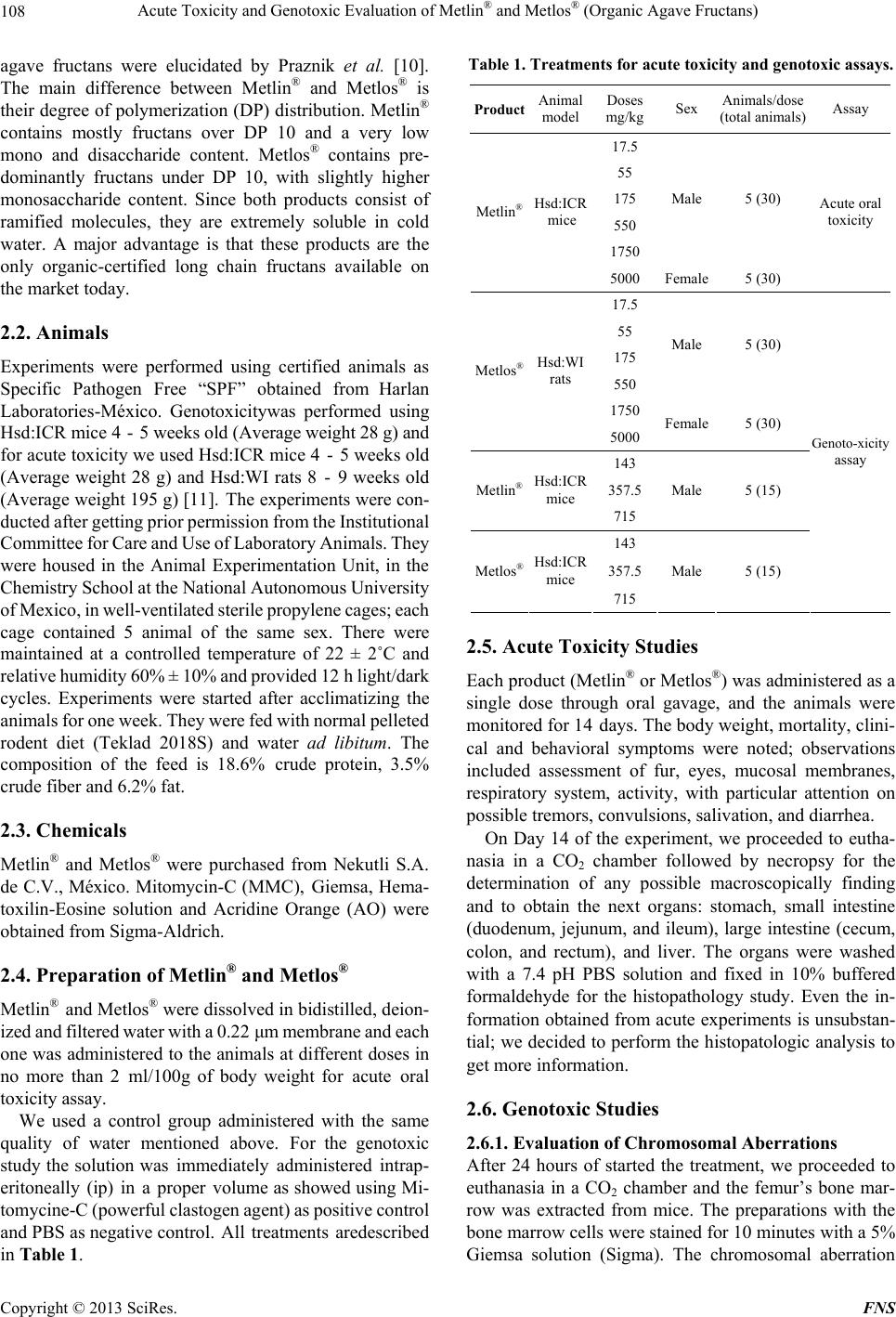 Acute Toxicity and Genotoxic Evaluation of Metlin® and Metlos® (Organic Agave Fructans) 108 agave fructans were elucidated by Praznik et al. [10]. The main difference between Metlin® and Metlos® is their degree of polymerization (DP) distribution. Metlin® contains mostly fructans over DP 10 and a very low mono and disaccharide content. Metlos® contains pre- dominantly fructans under DP 10, with slightly higher monosaccharide content. Since both products consist of ramified molecules, they are extremely soluble in cold water. A major advantage is that these products are the only organic-certified long chain fructans available on the market today. 2.2. Animals Experiments were performed using certified animals as Specific Pathogen Free “SPF” obtained from Harlan Laboratories-México. Genotoxicitywas performed using Hsd:ICR mice 4 - 5 weeks old (Average weight 28 g) and for acute toxicity we used Hsd:ICR mice 4 - 5 weeks old (Average weight 28 g) and Hsd:WI rats 8 - 9 weeks old (Average weight 195 g) [11]. The experiments were con- ducted after getting prior permission from the Institutional Committee for Care and Use of Laboratory Animals. They were housed in the Animal Experimentation Unit, in the Chemistry School at the National Autonomous University of Mexico, in well-ventilated sterile propylene cages; each cage contained 5 animal of the same sex. There were maintained at a controlled temperature of 22 ± 2˚C and relative humidity 60% ± 10% and provided 12 h light/dark cycles. Experiments were started after acclimatizing the animals for one week. They were fed with normal pelleted rodent diet (Teklad 2018S) and water ad libitum. The composition of the feed is 18.6% crude protein, 3.5% crude fiber and 6.2% fat. 2.3. Chemicals Metlin® and Metlos® were purchased from Nekutli S.A. de C.V., México. Mitomycin-C (MMC), Giemsa, Hema- toxilin-Eosine solution and Acridine Orange (AO) were obtained from Sigma-Aldrich. 2.4. Preparation of Metlin® and Metlos® Metlin® and Metlos® were dissolved in bidistilled, deion- ized and filtered water with a 0.22 μm membrane and each one was administered to the animals at different doses in no more than 2 ml/100g of body weight for acute oral toxicity assay. We used a control group administered with the same quality of water mentioned above. For the genotoxic study the solution was immediately administered intrap- eritoneally (ip) in a proper volume as showed using Mi- tomycine-C (powerful clastogen agent) as positive control and PBS as negative control. All treatments aredescribed in Table 1. Table 1. Treatments for acute toxicity and genotoxic assays. Product Animal model Doses mg/kg Sex Animals/dose (total animals) Assay 17.5 55 175 550 1750 Male 5 (30) Metlin®Hsd:ICR mice 5000 Female 5 (30) Acute oral toxicity 17.5 55 175 550 Male 5 (30) 1750 Metlos®Hsd:WI rats 5000 Female 5 (30) 143 357.5 Metlin®Hsd:ICR mice 715 Male 5 (15) 143 357.5 Metlos®Hsd:ICR mice 715 Male 5 (15) Genoto-xicity assay 2.5. Acute Toxicity Studies Each product (Metlin® or Metlos®) was administered as a single dose through oral gavage, and the animals were monitored for 14 days. The body weight, mortality, clini- cal and behavioral symptoms were noted; observations included assessment of fur, eyes, mucosal membranes, respiratory system, activity, with particular attention on possible tremors, convulsions, salivation, and diarrhea. On Day 14 of the experiment, we proceeded to eutha- nasia in a CO2 chamber followed by necropsy for the determination of any possible macroscopically finding and to obtain the next organs: stomach, small intestine (duodenum, jejunum, and ileum), large intestine (cecum, colon, and rectum), and liver. The organs were washed with a 7.4 pH PBS solution and fixed in 10% buffered formaldehyde for the histopathology study. Even the in- formation obtained from acute experiments is unsubstan- tial; we decided to perform the histopatologic analysis to get more information. 2.6. Genotoxic Studies 2.6.1. Evaluation of Chromosomal Aberrations After 24 hours of started the treatment, we proceeded to euthanasia in a CO2 chamber and the femur’s bone mar- row was extracted from mice. The preparations with the bone marrow cells were stained for 10 minutes with a 5% Giemsa solution (Sigma). The chromosomal aberration Copyright © 2013 SciRes. FNS 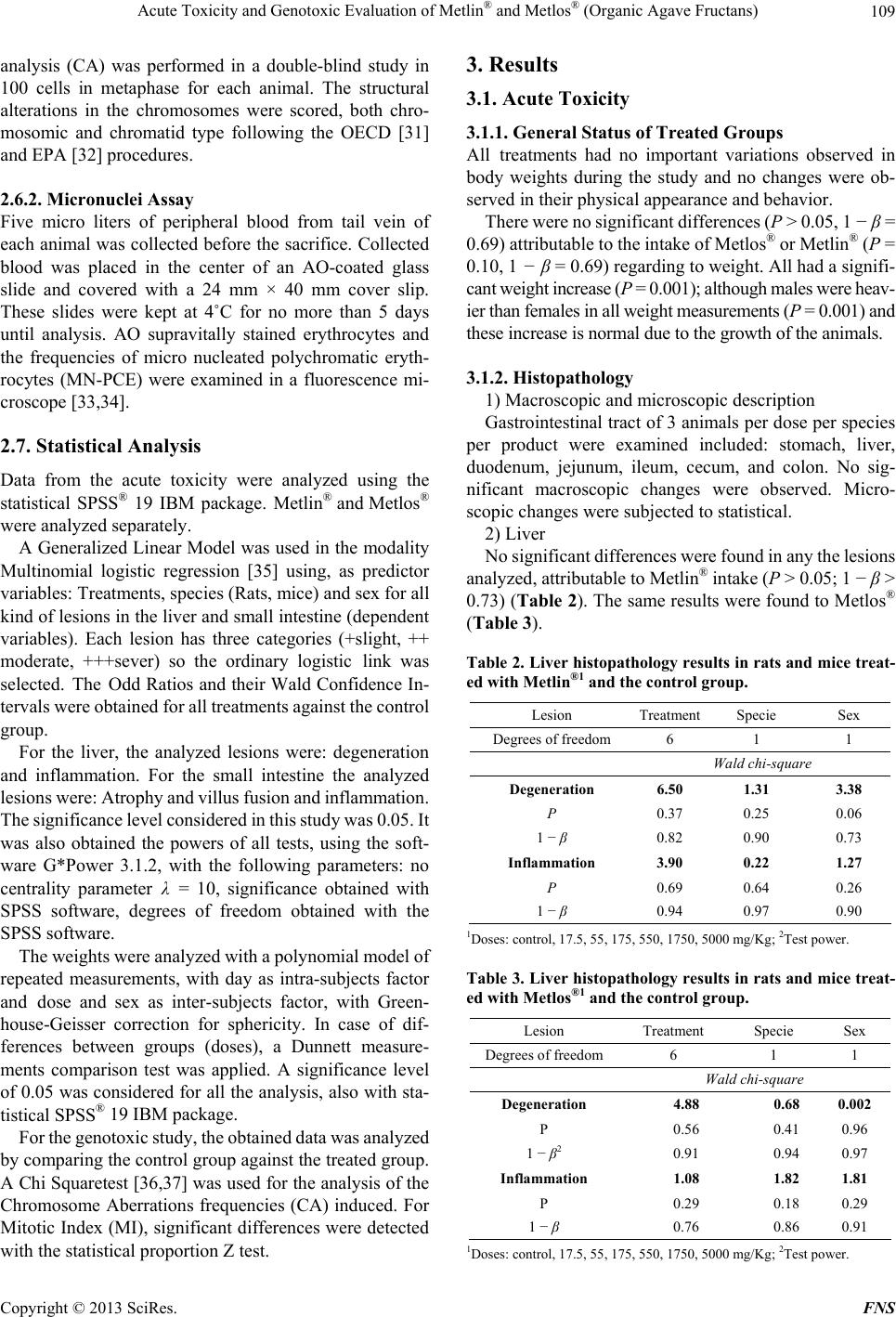 Acute Toxicity and Genotoxic Evaluation of Metlin® and Metlos® (Organic Agave Fructans) 109 analysis (CA) was performed in a double-blind study in 100 cells in metaphase for each animal. The structural alterations in the chromosomes were scored, both chro- mosomic and chromatid type following the OECD [31] and EPA [32] procedures. 2.6.2. Micronu clei Assay Five micro liters of peripheral blood from tail vein of each animal was collected before the sacrifice. Collected blood was placed in the center of an AO-coated glass slide and covered with a 24 mm × 40 mm cover slip. These slides were kept at 4˚C for no more than 5 days until analysis. AO supravitally stained erythrocytes and the frequencies of micro nucleated polychromatic eryth- rocytes (MN-PCE) were examined in a fluorescence mi- croscope [33,34]. 2.7. Statistical Analysis Data from the acute toxicity were analyzed using the statistical SPSS® 19 IBM package. Metlin® and Metlos® were analyzed separately. A Generalized Linear Model was used in the modality Multinomial logistic regression [35] using, as predictor variables: Treatments, species (Rats, mice) and sex for all kind of lesions in the liver and small intestine (dependent variables). Each lesion has three categories (+slight, ++ moderate, +++sever) so the ordinary logistic link was selected. The Odd Ratios and their Wald Confidence In- tervals were obtained for all treatments against the control group. For the liver, the analyzed lesions were: degeneration and inflammation. For the small intestine the analyzed lesions were: Atrophy and villus fusion and inflammation. The significance level considered in this study was 0.05. It was also obtained the powers of all tests, using the soft- ware G*Power 3.1.2, with the following parameters: no centrality parameter λ = 10, significance obtained with SPSS software, degrees of freedom obtained with the SPSS software. The weights were analyzed with a polynomial model of repeated measurements, with day as intra-subjects factor and dose and sex as inter-subjects factor, with Green- house-Geisser correction for sphericity. In case of dif- ferences between groups (doses), a Dunnett measure- ments comparison test was applied. A significance level of 0.05 was considered for all the analysis, also with sta- tistical SPSS® 19 IBM package. For the genotoxic study, the obtained data was analyzed by comparing the control group against the treated group. A Chi Squaretest [36,37] was used for the analysis of the Chromosome Aberrations frequencies (CA) induced. For Mitotic Index (MI), significant differences were detected with the statistical proportion Z test. 3. Results 3.1. Acute Toxicity 3.1.1. General Status of Treated Groups All treatments had no important variations observed in body weights during the study and no changes were ob- served in their physical appearance and behavior. There were no significant differences (P > 0.05, 1 − β = 0.69) attributable to the intake of Metlos® or Metlin® (P = 0.10, 1 − β = 0.69) regarding to weight. All had a signifi- cant weight increase (P = 0.001); although males were heav- ier than females in all weight measurements (P = 0.001) and these increase is normal due to the growth of the animals. 3.1.2. Hi stopathology 1) Macroscopic and microscopic description Gastrointestinal tract of 3 animals per dose per species per product were examined included: stomach, liver, duodenum, jejunum, ileum, cecum, and colon. No sig- nificant macroscopic changes were observed. Micro- scopic changes were subjected to statistical. 2) Liver No significant differences were found in any the lesions analyzed, attributable to Metlin® intake (P > 0.05; 1 − β > 0.73) (Table 2). The same results were found to Metlos® (Table 3). Table 2. Liver histopathology results in rats and mice treat- ed with Metlin®1 and the control group. Lesion Treatment Specie Sex Degrees of freedom 6 1 1 Wald chi-square Degeneration 6.50 1.31 3.38 P 0.37 0.25 0.06 1 − β 0.82 0.90 0.73 Inflammation 3.90 0.22 1.27 P 0.69 0.64 0.26 1 − β 0.94 0.97 0.90 1Doses: control, 17.5, 55, 175, 550, 1750, 5000 mg/Kg; 2Test power. Table 3. Liver histopathology results in rats and mice treat- ed with Metlos®1 and the control group. Lesion Treatment Specie Sex Degrees of freedom 6 1 1 Wald chi-square Degeneration 4.88 0.68 0.002 P 0.56 0.41 0.96 1 − β2 0.91 0.94 0.97 Inflammation 1.08 1.82 1.81 P 0.29 0.18 0.29 1 − β 0.76 0.86 0.91 1Doses: control, 17.5, 55, 175, 550, 1750, 5000 mg/Kg; 2Test power. Copyright © 2013 SciRes. FNS  Acute Toxicity and Genotoxic Evaluation of Metlin® and Metlos® (Organic Agave Fructans) Copyright © 2013 SciRes. FNS 110 3) Small intestine In the intestine lesions, no significant differences were attributable to the intake of Metlin® (P > 0.05, 0.53 ≤ 1 − β ≤ 0.99) (Table 4) or Metlos® (P > 0.05, 0.91 ≤ 1 − β ≤ 0.99 (Table 5). 4) Stomach No relevant lesion or findings at microscope analysis. 3.2. Chromosome Aberrations The results from the bone marrow chromosome analysis treated with Metlin® and Metlos® are shown on Tables 6 and 7. Data showed that in both treated groups the simple chromosomal aberrations frequency, such as fragments and deletions are within the normal range, when com- pareing against the negative control group. In the case of the positive control groups treated with MMC, the chromosomal alteration frequency was sub- stantially higher and statistically significant when com- pared with the negative control group. Finally, when the mitotic index was analyzed as a cy- totoxicity parameter, it was observed that in none of these treatments the index was modified, with the exception of the group treated with MMC, which decreased signifi- cantly. 3.3. Micronuclei Analysis As an additional parameter for the genotoxic study, an analysis of the micronucleus frequency present in the peripheral blood erythrocytes from mice. The results shown in Tables 8 and 9, indicate that neither Metlin® or Metlos® increased the micronuclei frequency. The ani- mals treated with MMC increase significantly when com- pared with the negative control group. Table 4. Small intestine histopathology in rats and mice treated with Metlin®1 and the control group. Lesion Treatment Specie Sex Degrees of freedom 6 1 1 Wald chi-square Atrophy and villus fusion2.21 0.041 0.697 P 0.89 0.84 0.40 1 − β 0.99 0.99 0.99 Inflammation 5.92 2.69 1.73 P 0.43 0.10 0.18 1 − β 0.99 0.96 0.98 1Doses: control, 17.5, 55, 175, 550, 1750, 5000 mg/Kg; 2Test power. Table 5. Small Intestine histopathology in rats and mice treated with Metlos®1 and the control group. Lesion Treatment Specie Sex Degrees of freedom 6 1 1 Wald chi-square Atrophy and villus fusion1.09 0.30 0.11 P 0.30 0.58 0.74 1 − β 0.91 0.99 0.99 Inflammation 2.77 0.01 1.61 P 0.84 0.99 0.20 1 − β 0.99 0.99 0.96 1Doses: control, 17.5, 55, 175, 550, 1750, 5000 mg/Kg; 2Test power. Table 6. Chromosomal alterations frequency in bone marrow cells of mice treated with Metlin®. Treatment mg/kg No. of miceNo. of cells Del. Fragm.Trans.Gaps % cells w/+ gaps % cells w/- gapsIM Control 5 500 5 6 - 7 3.6 2.2 4.2 +Control (MMC) 4 400 35 42 4 25 26.5 20.25* 1.1** 143 5 500 7 8 - 9 4.8 3.0 5.4 357.5 5 500 6 7 - 10 4.6 2.6 3.9 715 5 500 4 9 - 8 4.2 2.6 4.0 Del = deletions; Fragm = fragmentations; Trans = translocations; IM = mitotic index; *P < 0.001 vs. negative control; **P < 0.01 vs. negative control. Table 7. Chromosomal alterations frequency in bone marrow cells of mice treated with Metlos®. Treatment mg/kg No. of miceNo. of cells Del. Fragm.Trans. Gaps % cells w/+ gaps % cells w/- gapsIM Control 5 500 4 6 - 6 3.2 2.0 3.9 +Control (MMC) 5 500 51 42 6 24 24.6* 19.80* 1.3** 143 5 500 8 8 - 7 4.6 3.2 4.4 357.5 5 500 3 3 1 11 3.6 1.4 3.7 715 5 500 8 6 - 9 4.6 2.8 3.0 D el = deletions; Fragm = fragmentations; Trans = translocations; IM = mitotic index; *P < 0.001 vs. negative control; **P < 0.01 vs. negative control. 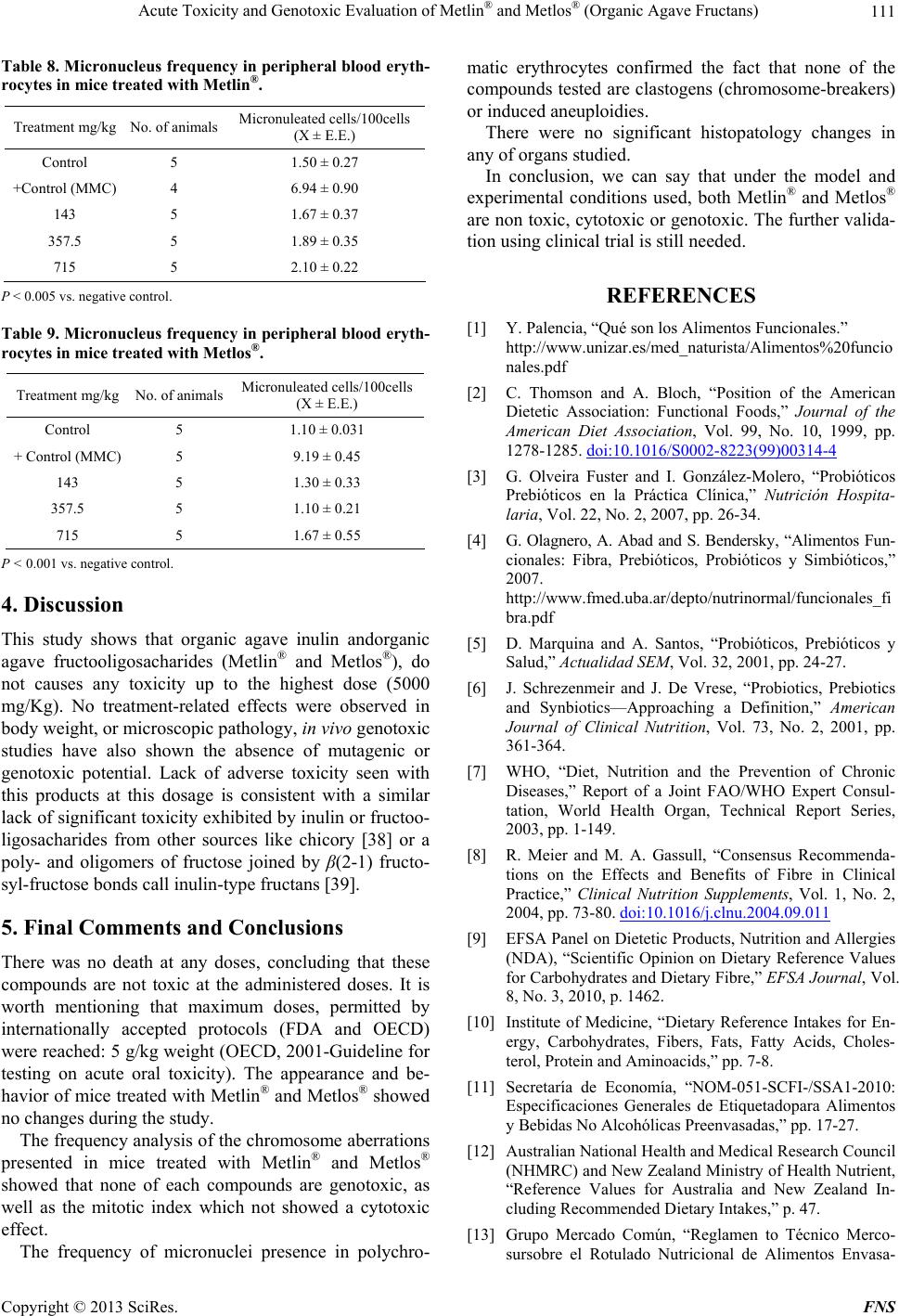 Acute Toxicity and Genotoxic Evaluation of Metlin® and Metlos® (Organic Agave Fructans) 111 Table 8. Micronucleus frequenc y in peripheral blood eryth- rocytes in mice treated with Metlin®. Treatment mg/kg No. of animals Micronuleated cells/100cells (X ± E.E.) Control 5 1.50 ± 0.27 +Control (MMC) 4 6.94 ± 0.90 143 5 1.67 ± 0.37 357.5 5 1.89 ± 0.35 715 5 2.10 ± 0.22 P < 0.005 vs. negative control. Table 9. Micronucleus frequenc y in peripheral blood eryth- rocytes in mice treated with Metlos®. Treatment mg/kg No. of animalsMicronuleated cells/100cells (X ± E.E.) Control 5 1.10 ± 0.031 + Control (MMC) 5 9.19 ± 0.45 143 5 1.30 ± 0.33 357.5 5 1.10 ± 0.21 715 5 1.67 ± 0.55 P < 0.001 vs. negative control. 4. Discussion This study shows that organic agave inulin andorganic agave fructooligosacharides (Metlin® and Metlos®), do not causes any toxicity up to the highest dose (5000 mg/Kg). No treatment-related effects were observed in body weight, or microscopic pathology, in vivo genotoxic studies have also shown the absence of mutagenic or genotoxic potential. Lack of adverse toxicity seen with this products at this dosage is consistent with a similar lack of significant toxicity exhibited by inulin or fructoo- ligosacharides from other sources like chicory [38] or a poly- and oligomers of fructose joined by β(2-1) fructo- syl-fructose bonds call inulin-type fructans [39]. 5. Final Comments and Conclusions There was no death at any doses, concluding that these compounds are not toxic at the administered doses. It is worth mentioning that maximum doses, permitted by internationally accepted protocols (FDA and OECD) were reached: 5 g/kg weight (OECD, 2001-Guideline for testing on acute oral toxicity). The appearance and be- havior of mice treated with Metlin® and Metlos® showed no changes during the study. The frequency analysis of the chromosome aberrations presented in mice treated with Metlin® and Metlos® showed that none of each compounds are genotoxic, as well as the mitotic index which not showed a cytotoxic effect. The frequency of micronuclei presence in polychro- matic erythrocytes confirmed the fact that none of the compounds tested are clastogens (chromosome-breakers) or induced aneuploidies. There were no significant histopatology changes in any of organs studied. In conclusion, we can say that under the model and experimental conditions used, both Metlin® and Metlos® are non toxic, cytotoxic or genotoxic. The further valida- tion using clinical trial is still needed. REFERENCES [1] Y. Palencia, “Qué son los Alimentos Funcionales.” http://www.unizar.es/med_naturista/Alimentos%20funcio nales.pdf [2] C. Thomson and A. Bloch, “Position of the American Dietetic Association: Functional Foods,” Journal of the American Diet Association, Vol. 99, No. 10, 1999, pp. 1278-1285. doi:10.1016/S0002-8223(99)00314-4 [3] G. Olveira Fuster and I. González-Molero, “Probióticos Prebióticos en la Práctica Clínica,” Nutrición Hospita- laria, Vol. 22, No. 2, 2007, pp. 26-34. [4] G. Olagnero, A. Abad and S. Bendersky, “Alimentos Fun- cionales: Fibra, Prebióticos, Probióticos y Simbióticos,” 2007. http://www.fmed.uba.ar/depto/nutrinormal/funcionales_fi bra.pdf [5] D. Marquina and A. Santos, “Probióticos, Prebióticos y Salud,” Actualidad SEM, Vol. 32, 2001, pp. 24-27. [6] J. Schrezenmeir and J. De Vrese, “Probiotics, Prebiotics and Synbiotics—Approaching a Definition,” American Journal of Clinical Nutrition, Vol. 73, No. 2, 2001, pp. 361-364. [7] WHO, “Diet, Nutrition and the Prevention of Chronic Diseases,” Report of a Joint FAO/WHO Expert Consul- tation, World Health Organ, Technical Report Series, 2003, pp. 1-149. [8] R. Meier and M. A. Gassull, “Consensus Recommenda- tions on the Effects and Benefits of Fibre in Clinical Practice,” Clinical Nutrition Supplements, Vol. 1, No. 2, 2004, pp. 73-80. doi:10.1016/j.clnu.2004.09.011 [9] EFSA Panel on Dietetic Products, Nutrition and Allergies (NDA), “Scientific Opinion on Dietary Reference Values for Carbohydrates and Dietary Fibre,” EFSA Journal, Vol. 8, No. 3, 2010, p. 1462. [10] Institute of Medicine, “Dietary Reference Intakes for En- ergy, Carbohydrates, Fibers, Fats, Fatty Acids, Choles- terol, Protein and Aminoacids,” pp. 7-8. [11] Secretaría de Economía, “NOM-051-SCFI-/SSA1-2010: Especificaciones Generales de Etiquetadopara Alimentos y Bebidas No Alcohólicas Preenvasadas,” pp. 17-27. [12] Australian National Health and Medical Research Council (NHMRC) and New Zealand Ministry of Health Nutrient, “Reference Values for Australia and New Zealand In- cluding Recommended Dietary Intakes,” p. 47. [13] Grupo Mercado Común, “Reglamen to Técnico Merco- sursobre el Rotulado Nutricional de Alimentos Envasa- Copyright © 2013 SciRes. FNS 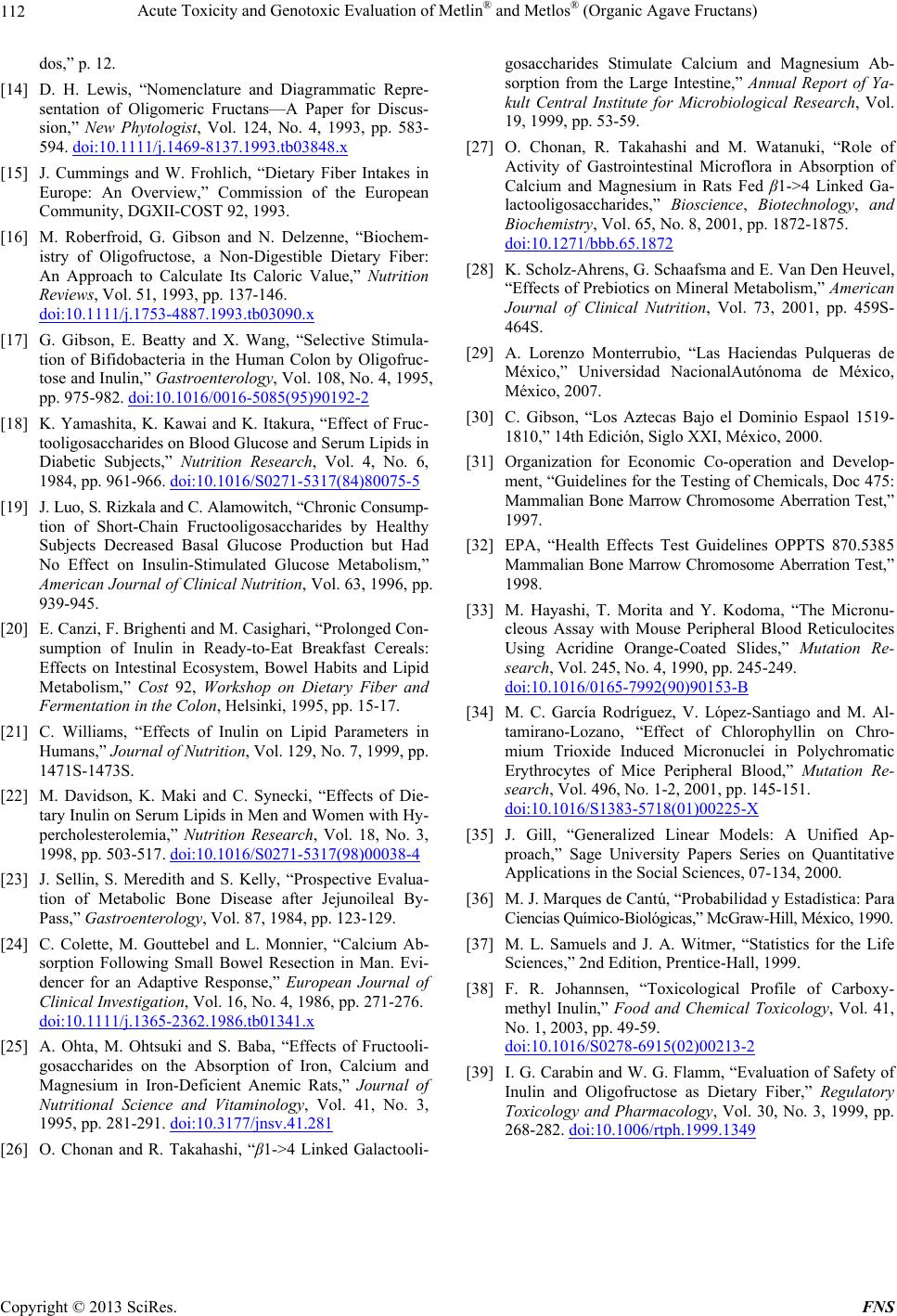 Acute Toxicity and Genotoxic Evaluation of Metlin® and Metlos® (Organic Agave Fructans) 112 dos,” p. 12. [14] D. H. Lewis, “Nomenclature and Diagrammatic Repre- sentation of Oligomeric Fructans—A Paper for Discus- sion,” New Phytologist, Vol. 124, No. 4, 1993, pp. 583- 594. doi:10.1111/j.1469-8137.1993.tb03848.x [15] J. Cummings and W. Frohlich, “Dietary Fiber Intakes in Europe: An Overview,” Commission of the European Community, DGXII-COST 92, 1993. [16] M. Roberfroid, G. Gibson and N. Delzenne, “Biochem- istry of Oligofructose, a Non-Digestible Dietary Fiber: An Approach to Calculate Its Caloric Value,” Nutrition Reviews, Vol. 51, 1993, pp. 137-146. doi:10.1111/j.1753-4887.1993.tb03090.x [17] G. Gibson, E. Beatty and X. Wang, “Selective Stimula- tion of Bifidobacteria in the Human Colon by Oligofruc- tose and Inulin,” Gastroenterology, Vol. 108, No. 4, 1995, pp. 975-982. doi:10.1016/0016-5085(95)90192-2 [18] K. Yamashita, K. Kawai and K. Itakura, “Effect of Fruc- tooligosaccharides on Blood Glucose and Serum Lipids in Diabetic Subjects,” Nutrition Research, Vol. 4, No. 6, 1984, pp. 961-966. doi:10.1016/S0271-5317(84)80075-5 [19] J. Luo, S. Rizkala and C. Alamowitch, “Chronic Consump- tion of Short-Chain Fructooligosaccharides by Healthy Subjects Decreased Basal Glucose Production but Had No Effect on Insulin-Stimulated Glucose Metabolism,” American Journal of Clinical Nutrition, Vol. 63, 1996, pp. 939-945. [20] E. Canzi, F. Brighenti and M. Casighari, “Prolonged Con- sumption of Inulin in Ready-to-Eat Breakfast Cereals: Effects on Intestinal Ecosystem, Bowel Habits and Lipid Metabolism,” Cost 92, Workshop on Dietary Fiber and Fermentation in the Colon, Helsinki, 1995, pp. 15-17. [21] C. Williams, “Effects of Inulin on Lipid Parameters in Humans,” Journal of Nutrition, Vol. 129, No. 7, 1999, pp. 1471S-1473S. [22] M. Davidson, K. Maki and C. Synecki, “Effects of Die- tary Inulin on Serum Lipids in Men and Women with Hy- percholesterolemia,” Nutrition Research, Vol. 18, No. 3, 1998, pp. 503-517. doi:10.1016/S0271-5317(98)00038-4 [23] J. Sellin, S. Meredith and S. Kelly, “Prospective Evalua- tion of Metabolic Bone Disease after Jejunoileal By- Pass,” Gastroen terology, Vol. 87, 1984, pp. 123-129. [24] C. Colette, M. Gouttebel and L. Monnier, “Calcium Ab- sorption Following Small Bowel Resection in Man. Evi- dencer for an Adaptive Response,” European Journal of Clinical Investigation, Vol. 16, No. 4, 1986, pp. 271-276. doi:10.1111/j.1365-2362.1986.tb01341.x [25] A. Ohta, M. Ohtsuki and S. Baba, “Effects of Fructooli- gosaccharides on the Absorption of Iron, Calcium and Magnesium in Iron-Deficient Anemic Rats,” Journal of Nutritional Science and Vitaminology, Vol. 41, No. 3, 1995, pp. 281-291. doi:10.3177/jnsv.41.281 [26] O. Chonan and R. Takahashi, “β1->4 Linked Galactooli- gosaccharides Stimulate Calcium and Magnesium Ab- sorption from the Large Intestine,” Annual Report of Ya- kult Central Institute for Microbiological Research, Vol. 19, 1999, pp. 53-59. [27] O. Chonan, R. Takahashi and M. Watanuki, “Role of Activity of Gastrointestinal Microflora in Absorption of Calcium and Magnesium in Rats Fed β1->4 Linked Ga- lactooligosaccharides,” Bioscience, Biotechnology, and Biochemistry, Vol. 65, No. 8, 2001, pp. 1872-1875. doi:10.1271/bbb.65.1872 [28] K. Scholz-Ahrens, G. Schaafsma and E. Van Den Heuvel, “Effects of Prebiotics on Mineral Metabolism,” American Journal of Clinical Nutrition, Vol. 73, 2001, pp. 459S- 464S. [29] A. Lorenzo Monterrubio, “Las Haciendas Pulqueras de México,” Universidad NacionalAutónoma de México, México, 2007. [30] C. Gibson, “Los Aztecas Bajo el Dominio Espaol 1519- 1810,” 14th Edición, Siglo XXI, México, 2000. [31] Organization for Economic Co-operation and Develop- ment, “Guidelines for the Testing of Chemicals, Doc 475: Mammalian Bone Marrow Chromosome Aberration Test,” 1997. [32] EPA, “Health Effects Test Guidelines OPPTS 870.5385 Mammalian Bone Marrow Chromosome Aberration Test,” 1998. [33] M. Hayashi, T. Morita and Y. Kodoma, “The Micronu- cleous Assay with Mouse Peripheral Blood Reticulocites Using Acridine Orange-Coated Slides,” Mutation Re- search, Vol. 245, No. 4, 1990, pp. 245-249. doi:10.1016/0165-7992(90)90153-B [34] M. C. García Rodríguez, V. López-Santiago and M. Al- tamirano-Lozano, “Effect of Chlorophyllin on Chro- mium Trioxide Induced Micronuclei in Polychromatic Erythrocytes of Mice Peripheral Blood,” Mutation Re- search, Vol. 496, No. 1-2, 2001, pp. 145-151. doi:10.1016/S1383-5718(01)00225-X [35] J. Gill, “Generalized Linear Models: A Unified Ap- proach,” Sage University Papers Series on Quantitative Applications in the Social Sciences, 07-134, 2000. [36] M. J. Marques de Cantú, “Probabilidad y Estadística: Para Ciencias Químico-Biológicas,” McGraw-Hill, México, 1990. [37] M. L. Samuels and J. A. Witmer, “Statistics for the Life Sciences,” 2nd Edition, Prentice-Hall, 1999. [38] F. R. Johannsen, “Toxicological Profile of Carboxy- methyl Inulin,” Food and Chemical Toxicology, Vol. 41, No. 1, 2003, pp. 49-59. doi:10.1016/S0278-6915(02)00213-2 [39] I. G. Carabin and W. G. Flamm, “Evaluation of Safety of Inulin and Oligofructose as Dietary Fiber,” Regulatory Toxicology and Pharmacology, Vol. 30, No. 3, 1999, pp. 268-282. doi:10.1006/rtph.1999.1349 Copyright © 2013 SciRes. FNS
|